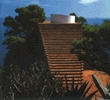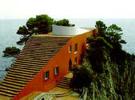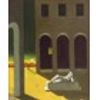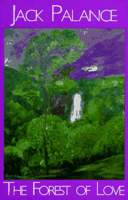Malaparte & Godard
|| "Every time I hear the word culture I bring out my cheque book," says Jack Palance in his role as a dominant ape in Godard's Contempt (Le Mepris, 1963). Actually he plays an American producer called Jerry Prokash who's in Italy to make a movie about Ulysses travelling hither and yonder in the Ancient World. The director? None other than the celebrated Fritz Lang, who plays himself. The Ulysses/Odyssey stuff is just a backdrop to a neurotic sex drama between the French chauvinist script writer Paul (Michel Piccoli) and his unhappy attractive wife Camille (Bridgett Bardot). It's familiar Godard territory, one he has explored more successfully in Breathless, Pierrot Le Fou, Le Petit Soldat... same principals, different actors.
Godard's male leads are usually just totems for himself, as they dress pretty much the same movie to movie: small fedoras and tight suits, which make them peculiar French parodies of American movie hoodlums of the film noir era. Godard's films are always improvisations, photo essays made on the fly... so repetition of theme is to be expected.
Many people like Contempt, see it as a hip insider's view of the movie business, and a damning of the Hollywood method -- that crass capitalistic credo that brutalizes old Europe and her prerogative in Art. Combine this with the usual Godard pop-art funkiness -- that iconographic magazine ad style -- wherein he collages an American star with a French star, has them directed by the maestro Fritz Lang, and what have you got? A post-modern multi-cultural classic?
Maybe. Others think this expensive in-joke (the slagging of producer Joseph E. Levine) is a tedious journey to Capri that's held up far too long in the writer's condo as he works out his neurosis about writing and women... and the only good parts are when Bardot removes her clothes. Real-time drama... an aesthetic ideal, sure, but the conversation better be good. Is it? Sometimes, but most surely repetitious. Are they going to accept Palance's invitation to the shoot on Capri? If so, is Paul pimping his wife? Ten thousand bucks for a script about Ulysses and Penelope is a lot more than he can get for writing a stage play in Paris. He slaps her around, screws her, has a glass of wine, a smoke... hmm, ten thousand bucks. At the core, you know he's a pimp, but there's a lot more talking and self-evaluation to go through before you're let out of this unfinished condo.
They go... finally, thank God. And it's on Capri that you see the real star of Contempt, the villa on the cliff known by architects and artists far and wide as the Casa Malaparte. The location is stunning: a rooftop patio high above the Mediterranean, near the rock of the sirens and the villa where the Roman Emperor Tiberius communed with the Gods. More or less the gateway to the mythological realm of the old Greco-Roman world. Bardot certainly looks good swimming naked in the warm blue water beneath the rugged limestone cliffs while the film crew goes about its business on the roof of the villa. The play-within-the-play... the script writer watches his wife from the boat landing below while the director watches his actors go through their moves on the patio above.
The curse of History, or the blessing of Modern Art? The setting here is brilliant insofar as the Casa Malaparte is a hybrid of ancient and modern architecture. In truth, the building looks quite shabby in 1962, its low squat profile, flaking stucco and rusting barred windows making it look like an abandoned artillery bunker from the Second World War. Could be German, could be Italian -- just like its creator, the writer Curzio Malaparte. Despite the condition, the dualism of the concept dominates... the rectilinear modernism of the actual building acting as support for the 32 steps that fan upwards to the flat roof like an inverted pyramid, creating an open platform theatre. No walls, no railings, no parapets... nothing to impede the view or the communion. This temple minimalism with its straight-line modernism and curved-line paganism exists in contradiction, a terminus to nowhere and somewhere simultaneously.
Art gallery primitivisim and the existential moment? Palance could care less. His only real interest is the pursuit of Bardot, who finds herself drawn to his brute animal vitalism like an Ayn Rand woman who is always drawn to a man with balls and money. It certainly isn't a relationship based on conversation, as neither can speak the other's language. They split together for Rome, driving a red sports car, another favorite prop of Godard's. And of course they crash and die in short order... the usual Godard fatalism. An easy moral about Europe and American capitalism? Or is Godard the Marxist tipping his hand towards the auratic violence of Futurist art and the cleansing fascism it extols? Or....
Malaparte & Kurt Erich Suckert
|| The surrealist duality of Curzio Malaparte a.k.a. Kurt Suckert (1898-1957) is rooted in his origin -- German father, Italian mother. "I try to be Italian like all the rest and I can't succeed," he says somewhere. He fought for Italy in the WW I, was wounded in a mustard gas attack near Reims, an event which is blamed for his death in 1957 from lung cancer... although photographs show him smoking cigarettes like most of his contemporaries. Photos also show him groomed in the style of Rudolph Valentino, fencing in Milan... or posing naked in the snow in Finland... talking with fellow writer Alberto Moravia [Contempt is based on Moravia's story Il disprezzo a.k.a. A Ghost At Noon]... looking unshaven and somber in a police mug shot... wearing a Captain's uniform of the Italian Alpine division... stripped-down and straddling a racing bike on the roof of the Casa Malaparte... or standing on the trapezoidal steps of a small church on the island of Lipari where he was exiled by Mussolini in 1933 (he taunted Il Duce for his poor choice of neckties).
According to Moravia (in his Life of Moravia) "The arrest was a joke... Malaparte saw his friends, his women, strolled along the beach in a bathing suit, holding his Lipari greyhound on a leash." Mouthy, theatrical, a self-promoter... his whole life is a fiction, a dream metaphor just like surrealist rhetoricist Breton's blazing locomotive in a wild forest.


He embraces fascism, Futurism -- indeed his writing gleams with the exalted poetic violence of a machine cult. He likes the idea of the fascist New Man, so in 1926 he adopts a new persona by changing his name to Curzio Malaparte (a crafty play on "Kurt" and "Bonaparte"), a manufactured Mediterranean handle that seems to sit well with the image of the fascist black shirt. Yet he's always in contradiction, a loose canon for whom propaganda is just another form of poetry. He visits Russia, writes a book on Lenin, has clear admiration for the machine-model of the Soviet. He visits Germany, calls Hitler a woman (Une Femme Hitler, 1932), has the SS talking to their opposites in Rome. He pisses off the Foreign Minister Italo Balbo, is arrested in 33 and exiled to the island of Lipari near Sicily. He is led in handcuffs through Naples, is followed by a dog called Frebo. Solitude now becomes his muse, and when he's repatriated he buys property on the eastern end of Capri, starts building a house on the dangerous cliffs of Punta Massullo.
"When I enter a grand hotel, my heart leaps with joy." (Malaparte, as quoted by Moravia)
Malaparte & Adalberto Libera
|| Many commentators see the Casa Malaparte as Malaparte's greatest work, surpassing even his superb writing. Certainly the project fits well with the Futurist idea of the Artist as Creator... a megalomaniacal notion also adopted by the French avant-gardist poet Antonin Artaud for his notion of a new theatre (Theatre of Cruelty). The stylistic contradiction -- is it rationalist or anti-rationalist -- fits perfectly with the surrealist dualism of conscious and unconscious expression. The rationalism comes from the original architect Libera (1903-63), who was published in an early issue of Prospettive a.k.a Perspective (1937-52) "an international journal of culture and the arts" that Malaparte produced and edited following his release from confinement. Libera was a favored architect with the fascist ruling elite, a hot item following the construction of his design for a new central post-office in Rome. The clean, simple arcade style of the post office's massed arches reconciled classicism with modernism, an integral precept of fascist aesthetic theory... and also seemed to play on the melancholy "Nietzche Autumn" atmosphere of the Italian surrealist/metaphysical painter Giorgio de Chirico, also published in Prospettive (strangely, de Chirico never mentions Malaparte in his elegantly paranoid Memoir). Libera's original design was so linear and rational it was institutional in the most basic sense, with nothing to distinguish it from a primitive Mediterranean stucco box, and could easily be mistaken for a prison or a military bunker. In this sense, it was merely a drawing in progress, a positioning of a shape in space.



No matter -- Libera and Malaparte fell out during the initial stages of construction, and Malaparte was left to continue building in whatever direction his contrarian mind led him. The dangerous siting and unregulated aesthetic -- this is no house for kids -- is viewed both as religious and classical, a sort of retro-pantheism worthy of the anthropomorphic world of the pre-Christian Romans. Close to the sun, close to the sea... close to Death. Casa Malaparte is a dream of flying, a dream of falling.
In his masterpiece, The Volga Rises In Europe (1943), Malaparte describes visiting a Finnish observation post during the brutal siege of Lenningrad. This "picket-post" is within 200 yards of the Russians, a simple bunker of stacked pines, mud and snow, manned by a single sentry -- the vartio, the "dead man", he who walks the point. Malaparte's sympathy for the man assigned to this suicidal location is enormous, so he leaves a couple of paks of ciggies behind as consolation. The description of the visit is grim and clairvoyant. Malaparte concludes: "As we trudge in single file along the narrow path a stray bullet whistles past my ear and lodges with a ping in a tree trunk. But I scarcely notice it. I am haunted by the memory of that wrinkled, tear-stained face, I cannot forget that weeping man standing alone in the forest." Describing himself? or the archetype of Man in a hostile universe? Casa Malaparte is a picket-post on the edge of Nowhere. As the architect Robert Venturi asks, "Do its steps lead to infinity?"
Malaparte and Fiction
|| Often quoted from Malaparte's bizarre non-fiction "novel" The Skin (La Pelle, 1952) is his description of a visit by the German General Erwin Rommel to the Casa Malaparte, en route to North Africa and a critical defeat by the British at el-Alamein. Some take it at face value, some as fiction. The "unreliable narrator"? Written as journalism, it reads as fiction. Written as fiction, it reads as poetry. Sound like the American "new journalism" of Wolfe, Mailer, Thompson, Didion, et. al.? It certainly does. A rejection of the fraudulent institutional 3rd person objectivity, the style is a return to the private, uninhibited view of the original 1st person singular journal writing. Cicero... Dafoe, Boswell, Byron... William Russell... Henry Miller, Jack Kerouac, Jean Genet, Anais Nin... Alexander Trocchi, William Burroughs... and of course Michael Herr. Herr's brilliant book about the Vietnam War, Dispatches, with its hallucinatory poeticism and transcendental values is clearly related to Malaparte's war journals/novels, especially The Volga Rises In Europe (1943) and Kaputt (44), even if Herr was unaware of Malaparte or his writing. Culture is an evolution, not a mimicry. Culture is extra-sensory, extends in sleep and dream.
Many resent Malaparte's insertion of himself into the central moments of 20th century history. Like some ancient prophet from the Bible, he's always there for the big moments and freely mixes fantasy with fact. Narcissism, Dux Italiano, the liar as artist and the nostalgia of the Mediterranean delusion. Sure... but the guy is a great writer.
Rommel asks Malaparte if he built this villa himself. No, he bought it as is... but he designed the scenery. The conceit is a joke, a surrealist pun. It pisses off the ideologue and the institutional maven. Truth is external event, not the chimera of the sleeping mind. Surrealism is a lie, a subversion of the secular being. Automism, the occult, dead classicism, dead gods, individualism and instinct. Bad. Malaparte. Bad. Poetry cannot coexist with the facts, for poetry is the mythologizing of the Big Lie. Yes... certainly accurate reportage is politically correct, and certainly only the sophisticated can follow such trans-dimensional narratives. The greedy, self-absorbed expression of the elitist? Possibly. But then, if art isn't elitist, is it art?
He painted it red, then he painted it white... then red again. What's in a color? Plenty, some think. According to Guiseppe Pardini (in his fine essay on Malaparte included in Michael McDonough's symposium) red was the preferred color of the fascist elite for their villas... or red was the color of Russia. Construction went slow when Malaparte was assigned as an Axis correspondent to cover the German invasion of Russia. As seen in The Volga Rises in Europe, his impressions are heretical, as they show sympathy for the adversary, and seem to reconcile the social models of Nazi Germany and Soviet Russia as similar mechanized versions of the New Man. War, indeed, is the Sorelian action drama, and he describes it with the lyricism of an action painting. A burnt female corpse, fused into the cockpit of a Russian tank, the prairie panorama of the German tanks advancing below "a screaming arch of Stukas", the faces of the dead beneath the ice fresco of Lake Lagoda... or this description of a German convoy en route from Greece to the Ukraine:
"Instinctively one knew that beneath the mask of the dust the soldiers' faces were scorched by the sun, pinched by the Greek wind. The men sat in strangely stiff attitudes; they had the appearance of statues. They were so white with dust that they looked as if they were made of marble. One of them had an owl, a live owl, perched on his fist... the bird undoubtedly came from the Acropolis, it was one of those owls who hoot at night among the marble columns of the Parthenon."
Yes, a beautiful snapshot... laced with Mediterranean revivalist nostalgia. No wonder the Casa Malaparte in some overhead b & w photos resembles a giant tank stranded on a cliff, a dream-fusion of classicist desire and Futurist war fantasy.
Quite possibly this imagery is romanticized too, as his friend Alberto Moravia used to take walks on Capri with an owl on his shoulder [this was in 1941 when Moravia, recently married to the writer Elsa Morante, hung out on the island].
The question must be asked: if no one knew Malaparte built this house, would it still draw the same religious attention? As a statement of autobiography, the fascination is obvious. "A house like me," is how the writer himself described it. Casa come me. In its decline following Malaparte's death in 1957 it has the shabby over-weighted ugliness of bad art deco... but now, in its recently restored splendor, it has the sleek lines of a metaphysical ship. The contradiction, the dualism, is as conflicted as Malaparte's death bed membership in the Chinese Communist Party and acceptance of the Catholic Last Rites.
we're all poets
 They're taking a break during the shooting of Contempt. Jean Luc and
Fritz are having a smoke, chatting in French... Bridgett is sunbathing on the
rocks like a basking mermaid. Palance? He's in the shade of the pines, reading.
He's read Malaparte's Kaputt and now he's reading The Skin. Jack knows a thing
or two about war, death and destruction... he was a bomber pilot, survived a
fiery crash... played a plague carrier in Panic in the Streets (1950), a marine
in The Halls of Montezuma and he can dig the way it was in Naples after the
Americans came... the way Curzio Malaparte describes it in The Skin. Grotesque,
he thinks. We look like idiots, talk like Hemingway, think like Presbyterians.
They say this is a masterpiece? The Rommel scene is good... Colonel Dolman, the
homosexual Nazi, yeah, funny... General Cork, the Prince of Candia, Consuelo,
Mrs. Flat, whores and dwarf women... and the guy called Jack. No, he's not so
funny. I dunno, think maybe Kaputt was better, less servile. He closes the
book, thinks about the other art film he was in, few years back, The Big
Knife, the Odets thing... a flop, no legs, fell like shit. Maybe this
Godard is gonna do the same... Palance begins to pace, recite. "I'll give you
poetry! Got a whole book in my head... The Forest of Love, yeah, one day
I'll write it all down... people will know Jack is not just a pretty face, he's
a poet!"
They're taking a break during the shooting of Contempt. Jean Luc and
Fritz are having a smoke, chatting in French... Bridgett is sunbathing on the
rocks like a basking mermaid. Palance? He's in the shade of the pines, reading.
He's read Malaparte's Kaputt and now he's reading The Skin. Jack knows a thing
or two about war, death and destruction... he was a bomber pilot, survived a
fiery crash... played a plague carrier in Panic in the Streets (1950), a marine
in The Halls of Montezuma and he can dig the way it was in Naples after the
Americans came... the way Curzio Malaparte describes it in The Skin. Grotesque,
he thinks. We look like idiots, talk like Hemingway, think like Presbyterians.
They say this is a masterpiece? The Rommel scene is good... Colonel Dolman, the
homosexual Nazi, yeah, funny... General Cork, the Prince of Candia, Consuelo,
Mrs. Flat, whores and dwarf women... and the guy called Jack. No, he's not so
funny. I dunno, think maybe Kaputt was better, less servile. He closes the
book, thinks about the other art film he was in, few years back, The Big
Knife, the Odets thing... a flop, no legs, fell like shit. Maybe this
Godard is gonna do the same... Palance begins to pace, recite. "I'll give you
poetry! Got a whole book in my head... The Forest of Love, yeah, one day
I'll write it all down... people will know Jack is not just a pretty face, he's
a poet!"
Malaparte & Michael McDonough
Is Michael McDonough's excellent study of Curzio Malaparte [Malaparte: A House Like Me, Clarkson Potter, New York 1999] a celebration or a rehabilitation? Both. McDonough says, "This book is intended as an impetus for Casa Malaparte's development as a site for international contemporary literature and art, and contemporary ideas in general." This study goes well beyond its coffee table attitude and nice pictures... it's a marvellous montage of photos, dynamite essays, concrete poetry, personalities.
© LR 2/05
LR's new novel [2015] RADIO BRAZIL »»
*check out LR's techno jazz evocation Malaparte mp3
Other writing about Malaparte:
Self-love Among the Ruins, Bruce
Chatwin, Vanity Fair, 1984
Casa Malaparte, Gianni Pettena, 1999
Casa
Malaparte, Karl Lagerfeld (photos)
Casa Malaparte, M. Talamona,
1992